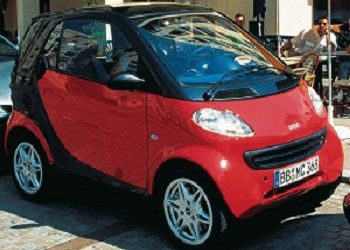The iconic Smart city car has its genesis in watchmaking rather than the automotive world, because the “father” of Smart was Hungarian-born entrepreneur Nicolas Hayek, creator of the cheap and trendy Swatch timepiece credited with reinvigorating Switzerland’s watch industry.

MCC Smart 1998
- YEAR REVEALED 1998
- PLACE OF ORIGIN Renningen, Germany, and Hambach, France
- HISTORICAL STATUS production car
- ENGINE three-cylinder, 37–43ci (599–698cc) gas and 49ci (799cc) diesel
- MAXIMUM POWER 61bhp
- LAYOUT rear-mounted engine driving the rear wheels
- BODYWORK three-door coupé and two-door convertible
- TOP SPEED 85mph (137kph)
- NUMBER BUILT 770,256
Hayek’s vision for a “Swatchmobile” featured interchangeable body panels, allowing buyers a wide choice of colors and finishes characteristic of Swatch watches. Original tenets also included pure electric and diesel-electric hybrid power, and a tiny “footprint” so two of the cars would occupy the space of one conventional sedan.
Swatch knew it couldn’t build the Smart car alone, however, and Mercedes-Benz became its production partner in the Micro Compact Car project in 1994. The stubby little car was based around what Smart called a Tridion safety cell, an exposed chassis-body frame encircling the cockpit and defining the exterior shape; on to this, the plastic body panels could be attached.
Mercedes-Benz developed a range of turbocharged three-cylinder engines for installation in the rear of the car, and all Smarts would come with a clutch-less transmission that could be driven in fully automatic or manual-shift modes.
The car’s stability and effective crumple zones gained the Smart a creditable three-star rating in Euro NCAP crash protection tests. The MCC Smart was unveiled in 1998, but Hayek sold his 19 percent stake in the venture to Mercedes.